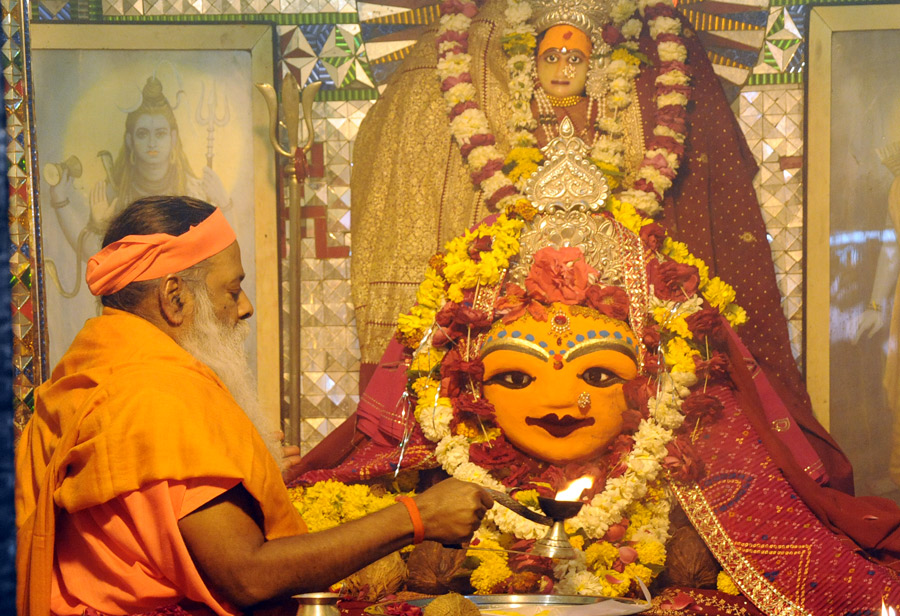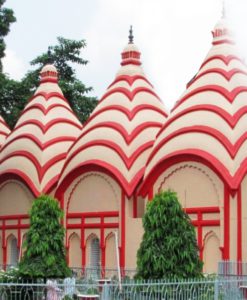No products in the cart.
Harsidhhi, a contracted form of “Harshad Amba” – The Happy Mother, is considered as one of the aspects of Amba and Kalika, the Hindu Devi. She is also known by the names like Harshal, Harshad, Harshat, Shikotar, Sikotar, Dasha, Momai and Vahanvati Mata. She is also known as Sindhoi Mata or Goddess of Sands, in Sindh in Pakistan, where her temple is located. Harshidhhi Mata Temple also known as Harshal Mata Temple is located at a place called Miani, some 30 km away from Porbandar en route to Dwarka. The main temple was originally located on a hill top facing the sea. One more famous temple is located in Rajpipla, where she is worshiped as Kuldevi by former princely State of Rajpipla, where she had come from Ujjain.
Her temples are found in Gujarat, Rajasthan, Madhya Pradesh and Maharashtra. Some of her noted temples are located in Porbandar, Indore, Jabalpur, Ladol, Dwarka, Wadhwan, Aurangabad, Badod, Varvala, Lunavada, Chand Baori, Haripura, Kutch, Rangir Rahli District Sagar Madhya Pradesh, and so on.
It is said Lord Krishna had worshiped her during his lifetime and has since been living atop hill called Koyla Dungar. The original temple atop the hill is said to be have been built by Lord Krishna himself. Lord Krishna wanted to defeat the asuras and Jarasandha so he prayed to Amba Mata for power. With the blessings of the goddess, Krishna was able to defeat the Asuras. After this success, he built the temple. When Jarasandha was killed, all Yadavas over overjoyed (harshit) and they celebrated their success here. Hence the name Harshad Mata or Harsiddhi Mata. She has since been worshiped as kuldevi of Yadavs. Seth Jagdu Shah of Kutch, a Jain merchant, was saved by Harsidhhi Mata, when his ships were sinking near the sea where her temple on the hill stood. He made a new temple in 1300AD below the hill and requested Devi to move down the hill, ever since many Jain castes worship her as Kuldevi.
The idol of Jagdu Shah is also situated to the right of Goddess’s idol inside the temple, which is also being worshiped as per boon given to Jagdu Shah that his name, henceforth, will forever be associated with this temple.
Legends say that once when Shiva and Parvati were alone on Mount Kailash, two demons called Chand and Prachand tried to force their way in. Shiva called upon Chandi to destroy them which she did. Pleased, Shiva bestowed upon her the epithet of ‘one who vanquishes all’. The temple was reconstructed during the Maratha period and the two pillars adorned with lamps are special features of Maratha art. These lamps, lit during Navaratri, present a glorious spectacle. There is an ancient well on the premises, and an artistic pillar adorns the top of it.
This temple occupies a special place in the galaxy of ancient sacred spots of Ujjain. Seated between the idols of Mahalaxmi and Mahasaraswati, the idol of Annapurna is painted in dark vermilion colour. The Sri Yantra, the symbol of power or shakti, is also enshrined in the temple. According to the Shiva Purana, when Shiva carried away the burning body of Sati from the sacrificial fire, her elbow dropped at this place. There is an interesting legend in the Skanda Purana about the manner in which the Goddess Chandi acquired the epithet of Harsiddhi. Vikramaditya is said to have visited Miyani, then known as Minalpur, a port city ruled by Prabhatsen Chavda of Chawda dynasty. Vikramadiya was blessed by the Devi. He requested Harsidhhi Mata, to come to her kingdom at Ujjain, where she would worship her daily. She is also known as Vahanvati Mata.
Aarti begins at 7 AM and 6 PM. The temple is open for devotees from 7 AM to 6 PM.
One among the fascinating aspect of this shrine is the structure which is made up of a rock smeared with turmeric paste and vermilion .The temple turns magnificient on the eve of the Navaratri festival, when hundreds of lamps on the 15 feet lamp stand being lit together. Yet another characteristic feature of the marvelous shrine is the presence of Sri Yantra, or nine triangles that represent nine names of Goddess Durga. This lovely shrine also houses images of other goddesses also. The famous dark vermilion image of Annapurna, the Goddess of Nourishment, and the idol of Mahasaraswati, the Goddess of Wisdom and Knowledge are significant for their typical Maratha architecture.
She is worshiped as Kuldevi by many Kshatriya and Rajput communities. The Chandrana clan of Lohanas, Brahmakshatriyas and many Jain castes along with Brahmin and Vaishya communities also worship her as their Kuldevi. She is also religiously worshiped by fishermen and other sea-faring tribes and people of Gujarat.
By Road
Harsiddhi Temple is a famous Temple in Ujjain, one can go to the temple by city bus and Tempo. It is minimum 4 km from the station to the temple. One can also take Autorikshaws and Tanga.By Rail
By Rail
The nearest railhead is the Dewas Railway Station at a distance of 40 km from the temple.
By Air
The nearest airport is the Devi Ahilya Bai Holkar Airport at a distance of 68 km from the temple.
Harsidhhi Temple, Ujjain, Madhya Pradesh










